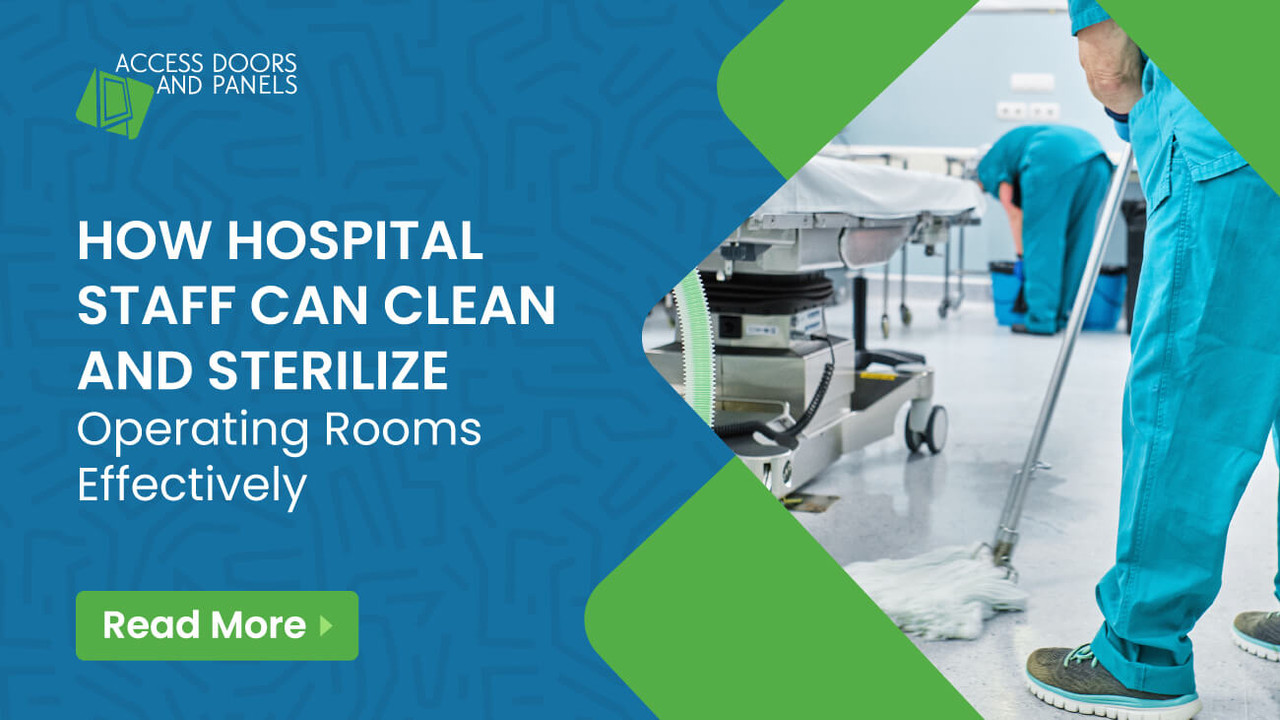How Hospital Staff Can Clean and Sterilize Operating Rooms Effectively
Posted by Access Doors and Panels on 21st Dec 2022
The cleanliness of the operating rooms before and after the procedure is a crucial part of the surgery. The whole area and the surgical and medical instruments must be disinfected and sterilized not to transmit bacteria, viruses, or any pathogens to the patient, as it can infect them and put their lives in critical condition.
It is also vital that the area has an airtight/watertight exterior access door to protect the critical components concealed behind walls, ceilings, or floors. Although these components have regular maintenance and repair checks, it is still essential that they are moisture-free to prevent them from malfunctioning, as it may cause put the life of the patient at risk.
Operating Room Turnover Cleaning Procedures.
The hospital staff must have specific operating cleaning procedures for effectively disinfecting and sterilizing operating rooms. But who cleans the operating room after surgery depends on the hospital's policy. After-surgery cleaners could be a sanitary team, janitorial services, or medical practitioners assigned to do the aftercare with the operating room cleaning checklist.
One operating room cleaning policy states that hospital staff must follow the following to ensure a clean and sterilized operating room.
The operating room must have dedicated carts and cleaning tools.
Whether the sanitary team cleans the operating rooms between cases or before the surgery, each room must have dedicated carts. Tools are necessary to prevent the spread and transmission of organisms through the carts and medical machines' wheels.
All cleaners, sanitizers, and disinfectants must be EPA-approved.
The Environmental Protection Agency (EPA) is a government agency that ensures that all chemicals used in cleaning are effective and safe for people and the environment.
Before the hospital staff prepares the cleaning solutions, they must ensure that the brands are all EPA-approved.
Only reprocess medical tools, equipment, and devices when it is in their designated area.
When cleaning medical devices for safe reuse, the medical staff must bring them to the appropriate area to avoid soiling the already cleaned instruments.
The team must also know that the entire operating room needs to be cleaned, disinfected, and sterilized. Thus, cleaning the equipment inside the operating room will only expose the other devices to pathogens that may infect the next patient during surgery.
Consider all linen, gowns, towels, and other cloths inside the OR soiled.
Whether the linens are new or not, the hospital staff must remove them after surgery, as everything inside the operating room is soiled.
Check for damaged electrical equipment, cords, and medical tools.
Some equipment and wirings should be moisture and corrosion-free, making it ideal to conceal them through gasketed access panels for safe access and protection. Check for any access panels within the operating room and see if the components are damaged.
Also, ensure all electrical equipment is off and unplugged from the electrical outlet. Unplugging the wire will prevent you from being electrocuted while cleaning the equipment. If there are any damages, the staff must report them to the supervisor or the officer in charge. Refer to the equipment's manual on how to clean it properly.
In line with this, the operating room must also have a Fire Extinguisher to put off the fire in case of fire accidents. Understandably, some hospitals prefer to hide the fire extinguishers and should only be accessible when needed. In cases like this, you may use the fire extinguisher cabinets.
Clean the table.
Cleaning the table requires extra work as you must clean it thoroughly, including the table's joints, legs, frame, and rail. The team must also clean any mattresses and coated pillows in the surgery room.
Before wiping it with a cleaning solution, the staff must wipe the table at least five times and allow it to air dry for at least three minutes.
Spot clean the floor.
Once done cleaning the medical equipment and the table, you need to clean and disinfect all the remaining soiled surfaces. The most effective way to clean the floor is to remove the dirt by moping the floor with a detergent and water.
After cleaning it with the solution, use a different bucket, rinse the floor with plain water, and let it dry. Lastly, using a third bucket, mop the floor with the hospital's preferred disinfectant solution.
Final Words
Cleaning the operating room ensures that the area is pathogens-free and that all cables, wires, medical equipment, and tools are moisture and corrosion-free. Thus, it is vital that you should use a durable and reliable access door to protect these cable wires and devices.
You must also know the importance of airtight and watertight access doors in laboratories and operating room in preventing air and water leakage into the theater.
Let Access Doors and Panels help you. Contact us at (888) 445-2115, and our team of experts will help you get the best access door you need!

